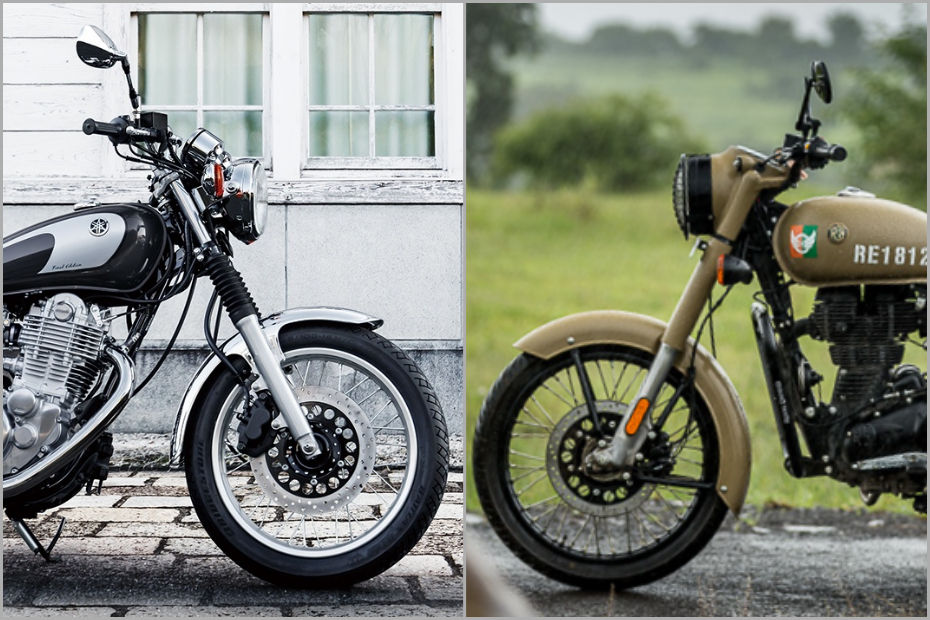Yamaha SR400 vs Royal Enfield Classic 350: Photo Comparison
Modified On Feb 8, 2021 02:56 PM By Praveen M. for Yamaha SR400
- 167663 Views
- Write a comment
Is the Japanese nostalgia-on-two-wheels any match for the desi Classic? Find out in our image comparison

To commemorate the end of its eventful 43-year lifespan, Yamaha has launched the Final Edition of the SR400 in Japan. Here’s how it stacks up against our own retro machine, the Royal Enfield Classic 350, in images:


The Yamaha SR400 has a distinctive retro roadster styling whereas the Royal Enfield Classic 350 gets an out-and-out vintage bike design. One thing is similar between the two bikes -- consistency. The design language of both motorcycles has remained more or less the same over several years.


The generous helping of chrome makes the SR400 stay closer to the past, whereas this particular variant of the Royal Enfield Classic 350 -- called the Signals Edition -- stays true to its military-themed makeover. Both bikes get simple halogen headlamps and bulb indicators. The telescopic fork seals are covered with old-school gaiters in the SR400, whereas the Classic 350 uses a smart body-coloured cover.


While the Yamaha SR400 gets a slightly more informative twin-pod cluster, the Classic 350 has to do with a minimalistic single-pod unit. A fuel gauge is absent on both the bikes, so riders will have to rely on just the low fuel lamp. Nevertheless, both consoles are delightfully old-school. We reckon enthusiasts don’t really mind their shortcomings as an unhindered riding experience is on top of their priority list. So too much information might only serve as a distraction for such riders.


The Yamaha SR400 gets a decent 12-litre tank, whereas the Classic 350’s slightly bulkier fuel tank can hold 13.5 litres of juice. Yamaha claims the motorcycle can return a mileage of 29.7kmpl, which is alright for an old-school air-cooled engine. On the other hand, the Royal Enfield Classic 350 returned 41.93kmpl in the city and 38.46kmpl on the highways in our real-world mileage tests.


At 790mm, the Yamaha SR400’s bench seat is slightly more accessible than the Royal Enfield Classic 350’s 800mm seat height. However, the latter features a split seat setup with a wide, sprung rider’s seat. This should theoretically offer better comfort.


The Yamaha SR400’s 399cc single-cylinder air-cooled, fuel-injected engine produces 24PS at 6500rpm and 28Nm at 3000rpm. On the other hand, the Royal Enfield Classic 350’s slightly smaller 346cc single-cylinder air-cooled fuel-injected motor churns out 19.14PS at 5250rpm and 28Nm at 4000rpm. One thing that stands out in the SR400 is its kick-starter. It gets a decompression mechanism, and the rider will have to use only the kick start lever to crank the motor. Royal Enfield offers the convenience of an electric starter as standard. Both engines are well known for their characteristic single-cylinder thump.

While the Yamaha SR400 gets a larger 298mm disc, it lacks ABS. Royal Enfield has offered a smaller 280mm unit but with the assurance of a dual-channel ABS. Both bikes get metal fenders for added authenticity.

At the rear, the Yamaha SR400 gets a traditional twin shock absorber setup with drum brake, whereas the Classic 350 features slightly more modern twin gas-charged units and a 240mm disc brake.
All in all, the two motorcycles have their own charm to stand apart in the sea of modern two-wheeled machines. It’s not the technology, but the character and soul these motorcycles pack that makes them great. If you’re wondering how the SR400 fares against the Classic 350 and the Honda H’Ness CB350, you should check this out.
